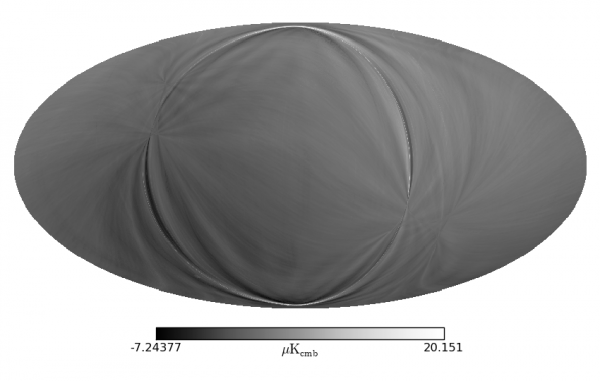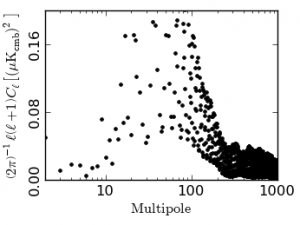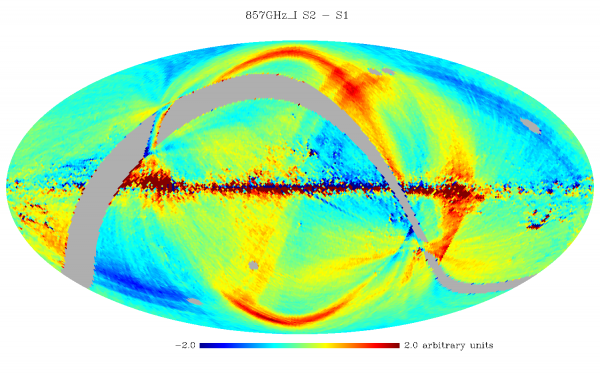Difference between revisions of "Map-making"
m |
|||
| Line 50: | Line 50: | ||
We also build maps from the two independent halves of each rings. Altogether, more than 6000 maps are built at each release. | We also build maps from the two independent halves of each rings. Altogether, more than 6000 maps are built at each release. | ||
| + | HPR and Maps are built in Galactic coordinates. | ||
== Noise properties == | == Noise properties == | ||
Revision as of 14:26, 11 February 2013
Contents
Map-Making and photometric calibration[edit]
Introduction[edit]
This page will give an overview of the map-making and photometric calibration procedures used by the HFI DPC to build detector and frequency maps. This processing and its performances are described in the the HFI DPC Paper and the the HFI DPC Calibration co-Paper [which will be completed prior to this page].
To build HFI maps, we use the destriping approximation, in which noise is assumed to decompose into two components : white noise plus low frequency drifts. Using the sky redundancy, the low frequency drifts are modelled as one constant, or offset, per pointing period. To speed up the ulterior processing we first build intermediate products, by taking advantage of redundancies : we average signal and detector orientation on healpix pixels visited during each fixed pointing period, which we call hereafter 'ring'. This intermediate product is called HPR for healpix pixel ring. They have been constructed using the same map resolution as the final HFI products (correspondontg to nside=2048). This new dataset is used as input in the following steps.
Photometric calibration[edit]
dipole calibration (100 to 353 GHz)[edit]
For the 2013 data release, the calibrator for the CMB frequency was the Solar dipole, as measured by the WMAP team (G. Hinshaw et al., Astrophys.J.Suppl.180:225-245,2009). We use a two components template fitting procedure, performed for each detector independently, to determine ring by ring an estimation of the dipole gain. The two fitted components are the Solar dipole and a sky template. We used the PSM for thermal dust emission at the detector's frequency as a first approximation of the sky template in pur early release. Using the HFI channel map as a template brings negligible change in the averaged gain, but reduces the systematic ring-to-ring dispersion of our estimation. We average these estimations over a subset of rings in the first survey (2000 to 6000) in which the dipole's amplitude is high enough with respect to that of the sky template, to get a single dipole gain per detector.
Several pieces of evidence led us to the conclusion that out bolometers presented apparent gain variation with time, after comparing the 3rd scan of the sky with the first one. This was later (mid-2012) explained by inequalities in the steps of the analog-to-digital converters (ADC) used in each bolometer's electronic chain. These devices had to be characterized using warm data after the end of the HFI observations. This process is still on-going (01/2012).
In the mean time we used an empiric correction, looking for a gain estimation and an offset per ring. This amounts to solve the non-linear equation :
where d is s the detector measurement, both S the sky signal, g the detector gain, O the offset (for ring no i) are the unknowns to be determined, and n the noise. We linearized this equation starting from the constant gain approximation, to get a measurement of the apparent time-varying gains for each bolometer independently. The limitations of this process are intrinsic signal variability from one observation to the other, like polarization or intra-pixel gradient. This procedure was thus only used for the 100 to 217 GHz detectors, for which the dipole signal is brighter and galactic signal (and polarization). A mask was used to removed the inner part of the Galactic plane.
Higher frequency calibration (545 and 857 GHz)[edit]
We therefore finally derived the sub-mm channels' calibration for the 2013 Planck data release from the comparison of measurements of the Neptune and Uranus fluxes (with aperture photometry) with their expectations from the Moreno et al model of their atmospheres' emission. This procedure is justified, since for both planets, at the lower frequencies (100-353 Ghz), the fluxes we recover are in agreement within ~ +/-5\% with what is expected from the planet spectral model, and the HFI detector's band-passes.
We determined zero-level for the released maps, by imposing that their average in regions where, according to HI template, dust emission is zero, be equal to that of the CIB model of Bethermin et al.
Building of Maps[edit]
Using the photometric calibration parameters, we build maps in two steps :
- we determine the destriping offsets using the full mission data
- we build the maps, using these offsets, by inverting the photometric equation :
where d is the destriped and calibrated signal at the HPR level. Detector's data are combined with an inverse noise weights derived from each detector's NEP. Q and U maps are build whenever possible. We propagate the white noise by building the 3x3 (or 1x1 if only I is reconstructed) covariance matrices in each pixel. At each frequency we build maps combining all detectors and independent detector sets. We use the offsets build for the full mission for building maps for each scan survey and for the nominal mission duration. We also build maps from the two independent halves of each rings. Altogether, more than 6000 maps are built at each release.
HPR and Maps are built in Galactic coordinates.
Noise properties[edit]
Map noise properties can be evaluated using several methods, thanks to the high level of observation redundancies. We can use the maps built from the difference between the first and second half of each rings, or compare individual sky scans, of detector sets with each other.
Low resolution (nside = 8, 16, 32 ?) pixel-to-pixel noise covariance matrices are build using an analytic approach from the measured noise power spectra.
Zodi correction[edit]
At the highest Planck frequencies, Zodiacal emission is visible in a survey difference map:
This map is a difference between the 857 GHz Survey 2 map and the 857 GHz Survey 1 map. This difference effectively removes Galactic and other emissions which originate far from Planck. As the Solar elongation is different for measurements of the same point on the sky for the two surveys, we see Zodiacal emission, while all emission from further sources is removed. The zodiacal emission follows the Ecliptic plane, which starts at the lower left of the image, then crosses the center of the plot towards the upper right. Note that the "arcs" at the top and bottom of the image are images of the Galactic center in the Far Sidelobes, which are discussed in the section below. Note also that the image above is from an early processing and will be updated.
Zodiacal Emission is removed from the 353, 545 and 857 GHz channels. It is described in the HFI DPC Paper, but a synopsis of the procedure is as follows:
- During each survey, a large fraction of the sky has observations which all fall within a week of each other. That is, during a single survey, most pixels are observed during a short, well-defined period. The contribution from Zodiacal Emission to the total brightness seen, then, is well defined.
- We use the the COBE model of the Zodiacal Light to make predictions for this Zodiacal emission for those pixels observed over a span of one week or less, and use GRASP models of the beams to predict the emission from the Galaxy given our sidelobes.
- We fit the survey difference maps with these model templates to estimate the emissivity of each Zodi component and sidelobe at the Planck wavelengths. The results of these fits at each frequency are shown here.
- We reconstruct each ring of the the full mission using the combination of the COBE geometric model with the emissivities determined above and the sidelobe models.
- We remove the reconstruction above from each ring of data.
- We then make maps as described previously in this section. Maps with and without, as well as the differences between the two, are shown here. The survey differences before and after this removal are shown with and without Zodical emission removal here. The power spectra of what is removed from each map is shown here.
Far Sidelobes[edit]
The far sidelobe correction for the highest frequency HFI channels is described in the section above. Note that this correction is done only for the 857 and 545 GHz channels, as it is not seen at longer wavelengths. As for the Zodical emission correction, it is not important for the CMB.
We have made estimates of the contamination of the far sidelobes at 143 GHz by taking the 143 GHz map, adding the dipole, and passing it through our simulator, using a GRASP calculation of the far sidelobes for the 143-1a detector as the beam. The resulting maps is shown here:

While there is one small region that might reach 20 micro-K (this happens when the secondary spillover overlaps with the Galactic center), most of the map is quite quiet. This is evidenced by the power spectrum of the above map, which is quite small.

CO Correction[edit]
The extraction of CO maps from HFI maps is described in detail in the the CO Paper. The CO maps are produced by a combination of bolometer maps or frequency maps. The method is summarized [|here]
Map validation[edit]
[LFI meaning]: absolute calibration refers to the 0th order calibration for each channel, 1 single number, while the relative calibration refers to the component of the calibration that varies pointing period by pointing period.
(Planck) High Frequency Instrument
Data Processing Center
Cosmic Microwave background
Planck Sky Model
analog to digital converter
Noise Equivalent Power
